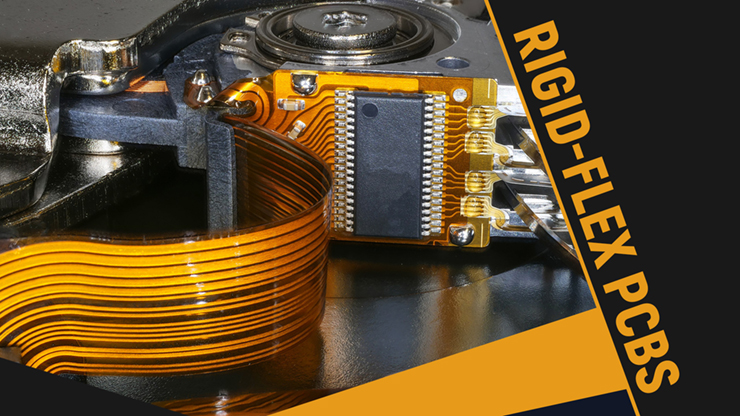by Ken Ghadia, Sales Engineer, TechnoTronix
Rigid-flex or rigid-flexible PCBs are the preferred interconnection circuits in today’s electronics. They have simplified the PCB assembly with superior mechanical stability and electrical reliability features. The driving factors for their popularity are reduced product weight, compact packaging, and quick assembly. Rigid-flex PCBs were designed primarily for critical interconnections in military equipment and avionics. Their market soon expanded to other domains as they performed well in harsh working environments like thermal shock, high pressure, and humidity.
By combining the benefits of rigid- and flex PCBs, circuit designers and packaging engineers implement three-dimensional packaging to utilize the product space effectively. The circuit includes a rigid PCB with flexible connecting elements designed to fold or roll into the final product’s shape. This technology has reduced product assembly time by almost 50%.
Today, advanced design tools support rigid-flex designs by defining bend areas, ensuring flex-aware placements, and validating the signal integrity of complex topologies. You can achieve higher productivity and optimize development costs using the industry’s latest electronic design automation (EDA) tools.
Flex and rigid-flex PCBs
A flex PCB is constructed using a flexible base material like polyimide. The circuit pattern etched with a conductive material is protected with a thin coating known as coverlay. This is similar to solder masks in rigid PCBs. The flexible material allows the PCB to bend multiple times without damaging the circuit.
In rigid-flexible PCBs, rigid boards are connected with flexible substrates. Usually, a rigid FR4 board is coupled with polyimide material on a copper cladding substrate. The flexible subcircuit is mainly used to replace cables and wire harnesses. Rigid-flexible PCBs are designed to bend in pre-defined flexible areas only. They are best used in “flex-to-install” applications, as repeated bending may cause circuit board cracks or breakage.
Merits of rigid-flex PCBs
The rigid-flex PCBs are cost-effective compared to the flex PCBs. There are several advantages of rigid-flex PCBs, which are listed below:
Compact product size: The reduced packaging requirements with one integrated unit replacing multiple connectors, wire harnesses, etc., make rigid-flex PCBs suitable for compact products. They can bend and fold into small areas and are ideal for miniaturization applications.
Improved Performance: Integration of rigid and flex areas significantly minimizes the solder joints, connectors, or crimps on the PCB. The potential failure points are fewer, with increased circuit consistency in rigid-flex PCBs.
Reduced cost: The small board size and fewer connector assemblies reduce the components and assembly cost of rigid-flex PCBs. They are comparatively cheaper than flex PCBs yet offer the benefits of flex circuits.
Flexible and compatible design: The 3D packaging ability of rigid-flex PCBs is a vital advantage contributing to its wide acceptance in almost all electronic applications. Any component used in rigid PCB designs, like BGAs and high-density surface-mount parts, can be included in the circuit. It also provides additional interconnect options like ZIF connectors.
Coherent testing: With all the subcircuits connected with the main design, automating the complete testing of rigid-flex PCBs is feasible. Any connectivity faults identified during bare board testing can avoid component damage post-assembly. This reduces material wastage and saves assembly costs.
Sustains in harsh environments: This is another crucial feature of rigid-flex PCBs allowing their vast deployment in military and aerospace applications. The polyimide material used in this design is best suited for high operating temperatures. Excellent mechanical strength and chemical resistance make them suitable for stringent operating conditions.
Challenges in building 4igid-flex PCBs
Rigid-flexible PCB fabrication is complex and depends on the material, stack configuration, hole size, via count, etc. One of the critical aspects of the rigid-flex PCB design is its board shape. The bending radius of the flex section defines the range of board movement. An accurate PCB stack-up with details on layer order, material, thickness, and other significant parameters has to be defined and shared with the PCB manufacturer. This is crucial in achieving a higher fabrication yield.
The three-dimensional packaging feature highlights the need for structural stability in rigid-flex PCBs. You must consider mechanical elements along with electrical parameters to prevent early board failures. Following layout guidelines can mitigate such issues:
- Plated through-holes should be avoided in flex areas as the bending line encounters mechanical stress and can weaken the padding strength.
- Trace routing should be straight and perpendicular to the bend line. Curved traces are recommended than sharp turns if the trace direction has to be changed on the flex section.
- Solid copper pour for ground planes can exert more pressure in flex areas. This can further reduce bending ability. Instead, using hatched polygons in the ground plane is a better strategy.
Before proceeding with PCB fabrication, you can simulate a 3D PCB model to verify component clearance and flex ranges. To control production expenses, choose a PCB manufacturer who can guide you through cost reduction with an optimal design.
Why choose rigid-flex PCBs
- Rigid PCBs are robust and cheap, while flex PCBs offer compact design and reliable performance. By integrating the benefits of both types, Rigid-flexible PCBs provide durable, high-density, and miniaturized solutions for various applications.
- The increasing sophistication and functionality of medical instruments depend on a high-reliability circuit. Rigid-flex PCBs can improve device consistency by minimizing contact points and eliminating cumbersome wirings.
- The tight packaging required in portable devices and wearables is possible by interconnecting multiple PCBs using rigid-flex technology.
- The reduced product weight supports circuit performance under a shock and vibrating environment. This makes rigid-flex PCBs perfect for military applications.
- High-speed signal transmission is achieved using controlled impedance interconnect traces in rigid-flex PCBs. This feature enables its usage in communication applications like wireless LANs and mobile phones.
- Rigid-flexible PCBs are also used in commercial and industrial applications as they can include more functionality in a smaller size. They reduce maintenance costs with enhanced product reliability.
Conclusion
The merits of rigid-flex PCBs are almost similar to flex PCBs. But the reduced cost and additional benefits of the rigid section make them a better choice for your next product. They have already penetrated several market segments and are widely accepted.






